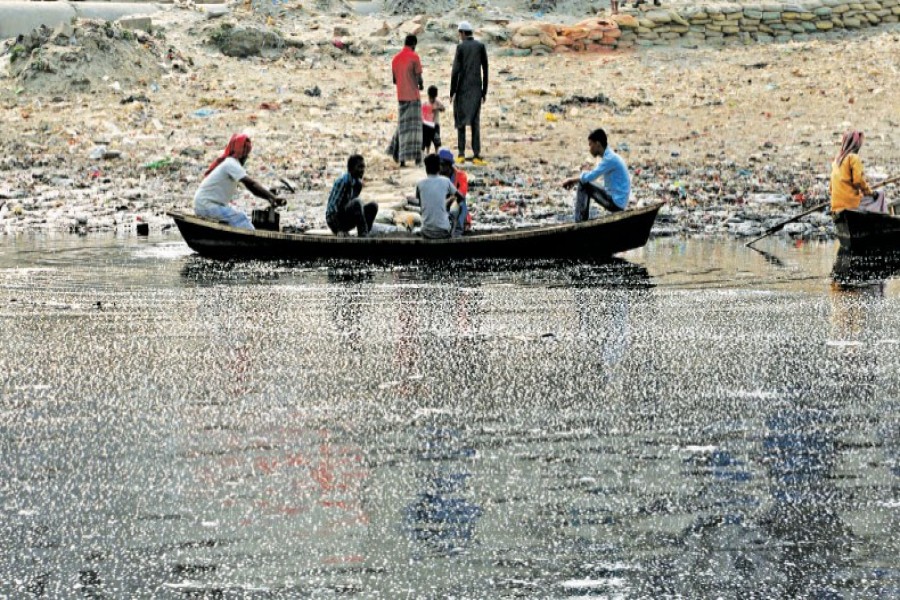The tannery industry is now polluting the Dhaleswari river after the Buriganga as the central effluent treatment plant (CETP) for treating liquid waste and hazardous chemicals is yet to be fully operational. For the last nine months, the Chinese company, which built the CETP, is running the plant on a trial basis. For getting maximum results, the plant should run round the clock. But the company shuts it down during power cuts which are common in Savar. Also the company does not supply all the necessary chemicals to treat waste and other harmful substances.
Contaminated water, mixed with high level of chromium and salt, is flowing into the Dhaleswari from the CETP. The company is allegedly releasing part of untreated waste water directly into the river through a bypass pipeline threatening the very survival of various aquatic resources. Analysing data collected before and after the installation of the treatment plant, experts found the river water containing all the chemicals used in tanneries to process raw hides. Heavy metals and other pollutants released from the tanneries were found in water samples. The level of chemical oxygen, biochemical oxygen and chromium in the water far exceeds the limit set by the Environment Conservation Rules 1997.
The China-Bangladesh joint venture company has again sought extension of the deadline for the construction of CETP up to June 2018.This is the seventh time the company sought extension of the deadline but there will be no increase in the project cost. The present deadline expired by December 31. The company was awarded the job in October 2012 to complete it in 18 months at a cost of Tk 4.8 billion. The consultant said this will be the last extension.
As many as 102 factories have been relocated to Savar but the CETP with its present condition would not be able to manage the wastes when all the factories will start running. According to Bangladesh Tanners Association, the establishment of a solid waste management system, sludge power generation system, fire service and development of adjacent roads are yet to be completed.
Although most of the tanneries have been moved from Hazaribagh to Horindhara in Savar, the area was not fully developed to house all the factories and its workers. Some 30,000 workers are engaged in the estate while most of them still have to reside in Hazaribagh as there is no good housing facility or school in Horindhara. Besides, there is no street light, no proper drainage system which frequently causes water-logging and not even any permanent solid waste dumping station in the area while the internal roads are in a sorry state. Workers are demanding that the authorities should build residential quarters, a school and a mosque in the area. The workers have to struggle to support their families with little income. Union leaders are demanding a monthly interim allowance of Tk 3,000 for the workers and a separate wage board for tannery workers.
Tannery industry started its journey in 1951 at Hazaribagh. None of the factories numbering 205 had any system for waste disposal. Harmful liquid waste used to flow directly to the Buriganga. Solid wastes were thrown on road sides and into water bodies. US-based environmental agency Pure Earth mentioned 10 most polluted areas in 2013. Hazaribagh was one of those places. The demand for relocating the polluting tanneries was voiced for a long time. This demand of the common people and environmentalists was fulfilled in 2017. Tanneries have moved to new location in Savar after 66 years.
Pollution of the Buriganga was the main reason for relocating tanneries. But now Dhaleswari is being polluted. The president of Finished Leather, Leather goods and Footwear Exporters Association has said operation of CETP has to be strictly monitored. A spot has to be fixed for dumping solid waste. Roads within the estate have also to be repaired.
The authorities have been alerted on a number of occasions about the continued degradation of the Dhaleswari river. Indiscriminate toxic waste is being dumped into the river by the relocated tanneries in the Savar area. The main point of relocation was to stop the severe pollution of the Buriganga. If the leather factories continue to pollute another river, the entire process will be meaningless and counter-productive. Everybody supported the government's bid to relocate the tannery industry to Savar. It was hoped that the valuable industry would operate in an environment friendly manner. If pollution continues unabated, the Dhaleswari will meet the same fate as that of the Buriganga.
The writer is an economist and columnist


